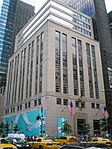Bergdorf Goodman

Bergdorf Goodman Inc. is a luxury department store based on Fifth Avenue in Midtown Manhattan, New York City. The company was founded in 1899 by Herman Bergdorf and was later owned and managed by Edwin Goodman, and later his son, Andrew Goodman. Today, Bergdorf Goodman operates from two stores situated across the street from each other at Fifth Avenue between 57th Street and 58th Streets. The main store, which opened at its current location in 1928, is located on the west side of Fifth Avenue. A separate men's store, established in 1990, is located on the east side of Fifth Avenue, directly across the street. Bergdorf Goodman is a subsidiary of Neiman Marcus, which is owned by the private equity firm Ares Management. Neiman Marcus, which owns Bergdorf Goodman, has officially filed for Chapter 11 bankruptcy following the impact of the COVID-19 pandemic.
Excerpt from the Wikipedia article Bergdorf Goodman (License: CC BY-SA 3.0, Authors, Images).Bergdorf Goodman
West 57th Street, New York Manhattan
Geographical coordinates (GPS) Address Nearby Places Show on map
Geographical coordinates (GPS)
| Latitude | Longitude |
|---|---|
| N 40.7635 ° | E -73.9742 ° |
Address
West 57th Street 3
10019 New York, Manhattan
New York, United States
Open on Google Maps








